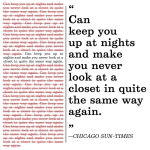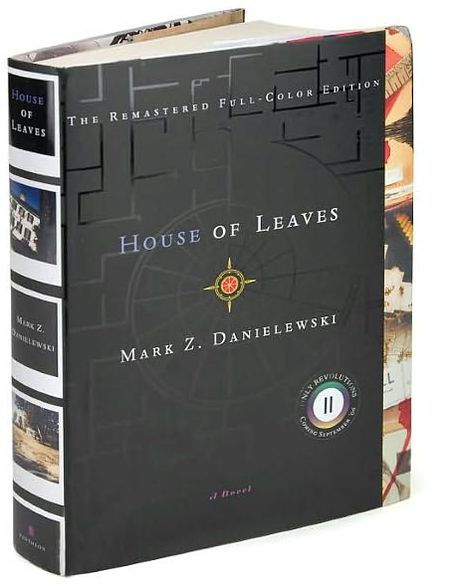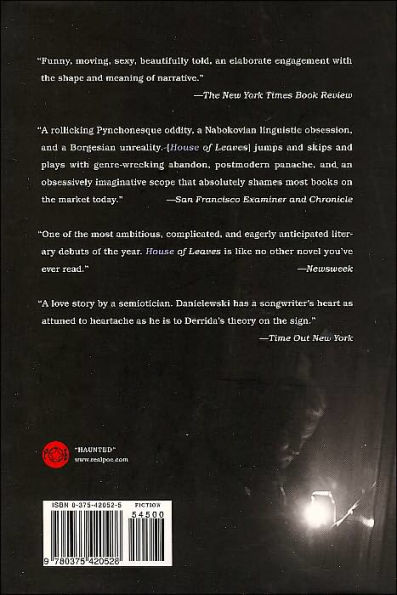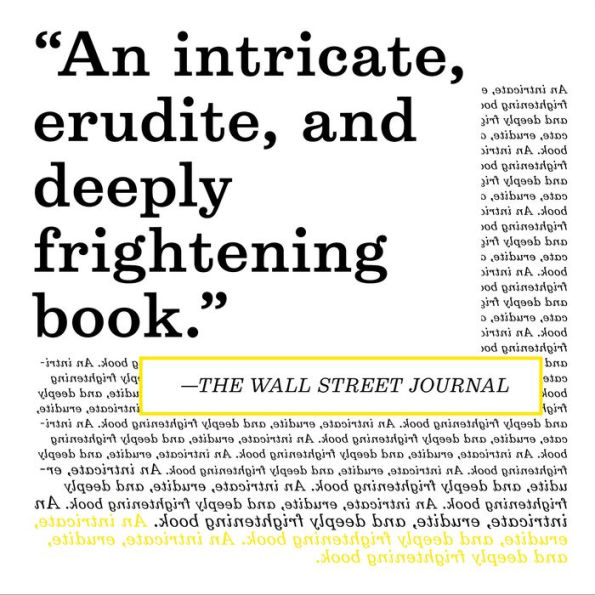House of Leaves: The Remastered, Full-Color Edition
THE MIND-BENDING CULT CLASSIC ABOUT A HOUSE THAT’S LARGER ON THE INSIDE THAN ON THE OUTSIDE • A masterpiece of horror and an astonishingly immersive, maze-like reading experience that redefines the boundaries of a novel.
''Simultaneously reads like a thriller and like a strange, dreamlike excursion into the subconscious." —Michiko Kakutani, The New York Times
"Thrillingly alive, sublimely creepy, distressingly scary, breathtakingly intelligent—it renders most other fiction meaningless." —Bret Easton Ellis, bestselling author of American Psycho
“This demonically brilliant book is impossible to ignore.” —Jonathan Lethem, award-winning author of Motherless Brooklyn
One of The Atlantic’s Great American Novels of the Past 100 Years
Years ago, when House of Leaves was first being passed around, it was nothing more than a badly bundled heap of paper, parts of which would occasionally surface on the Internet. No one could have anticipated the small but devoted following this terrifying story would soon command. Starting with an odd assortment of marginalized youth—musicians, tattoo artists, programmers, strippers, environmentalists, and adrenaline junkies—the book eventually made its way into the hands of older generations, who not only found themselves in those strangely arranged pages but also discovered a way back into the lives of their estranged children.
Now made available in book form, complete with the original colored words, vertical footnotes, and second and third appendices, the story remains unchanged. Similarly, the cultural fascination with House of Leaves remains as fervent and as imaginative as ever. The novel has gone on to inspire doctorate-level courses and masters theses, cultural phenomena like the online urban legend of “the backrooms,” and incredible works of art in entirely unrealted mediums from music to video games.
Neither Pulitzer Prize-winning photojournalist Will Navidson nor his companion Karen Green was prepared to face the consequences of the impossibility of their new home, until the day their two little children wandered off and their voices eerily began to return another story—of creature darkness, of an ever-growing abyss behind a closet door, and of that unholy growl which soon enough would tear through their walls and consume all their dreams.
1103027816
''Simultaneously reads like a thriller and like a strange, dreamlike excursion into the subconscious." —Michiko Kakutani, The New York Times
"Thrillingly alive, sublimely creepy, distressingly scary, breathtakingly intelligent—it renders most other fiction meaningless." —Bret Easton Ellis, bestselling author of American Psycho
“This demonically brilliant book is impossible to ignore.” —Jonathan Lethem, award-winning author of Motherless Brooklyn
One of The Atlantic’s Great American Novels of the Past 100 Years
Years ago, when House of Leaves was first being passed around, it was nothing more than a badly bundled heap of paper, parts of which would occasionally surface on the Internet. No one could have anticipated the small but devoted following this terrifying story would soon command. Starting with an odd assortment of marginalized youth—musicians, tattoo artists, programmers, strippers, environmentalists, and adrenaline junkies—the book eventually made its way into the hands of older generations, who not only found themselves in those strangely arranged pages but also discovered a way back into the lives of their estranged children.
Now made available in book form, complete with the original colored words, vertical footnotes, and second and third appendices, the story remains unchanged. Similarly, the cultural fascination with House of Leaves remains as fervent and as imaginative as ever. The novel has gone on to inspire doctorate-level courses and masters theses, cultural phenomena like the online urban legend of “the backrooms,” and incredible works of art in entirely unrealted mediums from music to video games.
Neither Pulitzer Prize-winning photojournalist Will Navidson nor his companion Karen Green was prepared to face the consequences of the impossibility of their new home, until the day their two little children wandered off and their voices eerily began to return another story—of creature darkness, of an ever-growing abyss behind a closet door, and of that unholy growl which soon enough would tear through their walls and consume all their dreams.
House of Leaves: The Remastered, Full-Color Edition
THE MIND-BENDING CULT CLASSIC ABOUT A HOUSE THAT’S LARGER ON THE INSIDE THAN ON THE OUTSIDE • A masterpiece of horror and an astonishingly immersive, maze-like reading experience that redefines the boundaries of a novel.
''Simultaneously reads like a thriller and like a strange, dreamlike excursion into the subconscious." —Michiko Kakutani, The New York Times
"Thrillingly alive, sublimely creepy, distressingly scary, breathtakingly intelligent—it renders most other fiction meaningless." —Bret Easton Ellis, bestselling author of American Psycho
“This demonically brilliant book is impossible to ignore.” —Jonathan Lethem, award-winning author of Motherless Brooklyn
One of The Atlantic’s Great American Novels of the Past 100 Years
Years ago, when House of Leaves was first being passed around, it was nothing more than a badly bundled heap of paper, parts of which would occasionally surface on the Internet. No one could have anticipated the small but devoted following this terrifying story would soon command. Starting with an odd assortment of marginalized youth—musicians, tattoo artists, programmers, strippers, environmentalists, and adrenaline junkies—the book eventually made its way into the hands of older generations, who not only found themselves in those strangely arranged pages but also discovered a way back into the lives of their estranged children.
Now made available in book form, complete with the original colored words, vertical footnotes, and second and third appendices, the story remains unchanged. Similarly, the cultural fascination with House of Leaves remains as fervent and as imaginative as ever. The novel has gone on to inspire doctorate-level courses and masters theses, cultural phenomena like the online urban legend of “the backrooms,” and incredible works of art in entirely unrealted mediums from music to video games.
Neither Pulitzer Prize-winning photojournalist Will Navidson nor his companion Karen Green was prepared to face the consequences of the impossibility of their new home, until the day their two little children wandered off and their voices eerily began to return another story—of creature darkness, of an ever-growing abyss behind a closet door, and of that unholy growl which soon enough would tear through their walls and consume all their dreams.
''Simultaneously reads like a thriller and like a strange, dreamlike excursion into the subconscious." —Michiko Kakutani, The New York Times
"Thrillingly alive, sublimely creepy, distressingly scary, breathtakingly intelligent—it renders most other fiction meaningless." —Bret Easton Ellis, bestselling author of American Psycho
“This demonically brilliant book is impossible to ignore.” —Jonathan Lethem, award-winning author of Motherless Brooklyn
One of The Atlantic’s Great American Novels of the Past 100 Years
Years ago, when House of Leaves was first being passed around, it was nothing more than a badly bundled heap of paper, parts of which would occasionally surface on the Internet. No one could have anticipated the small but devoted following this terrifying story would soon command. Starting with an odd assortment of marginalized youth—musicians, tattoo artists, programmers, strippers, environmentalists, and adrenaline junkies—the book eventually made its way into the hands of older generations, who not only found themselves in those strangely arranged pages but also discovered a way back into the lives of their estranged children.
Now made available in book form, complete with the original colored words, vertical footnotes, and second and third appendices, the story remains unchanged. Similarly, the cultural fascination with House of Leaves remains as fervent and as imaginative as ever. The novel has gone on to inspire doctorate-level courses and masters theses, cultural phenomena like the online urban legend of “the backrooms,” and incredible works of art in entirely unrealted mediums from music to video games.
Neither Pulitzer Prize-winning photojournalist Will Navidson nor his companion Karen Green was prepared to face the consequences of the impossibility of their new home, until the day their two little children wandered off and their voices eerily began to return another story—of creature darkness, of an ever-growing abyss behind a closet door, and of that unholy growl which soon enough would tear through their walls and consume all their dreams.
55.0
In Stock
5
1

House of Leaves: The Remastered, Full-Color Edition
736
House of Leaves: The Remastered, Full-Color Edition
736Hardcover(2nd ed.)
$55.00
55.0
In Stock

Product Details
| ISBN-13: | 9780375420528 |
|---|---|
| Publisher: | Knopf Doubleday Publishing Group |
| Publication date: | 03/07/2000 |
| Edition description: | 2nd ed. |
| Pages: | 736 |
| Sales rank: | 12,263 |
| Product dimensions: | 7.37(w) x 9.43(h) x 1.48(d) |
About the Author

What People are Saying About This
From the B&N Reads Blog









